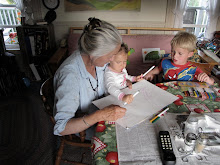Dear Senor Machon,
To add to my first communication with you about your book on children's drawings and about my own work in the field of children's drawings; I have just finished 3 weeks working with drawing and writing in the orphanage Ninos de Cristo in La Romana province in the Dominican Republic, thanks to the permission of directors Sonia Hane, and Carmen Ruiz, as well as to the general support of the teachers Nancy, Sonia, and Ani. In many cases, the drawings of boys who were the least powerful with words were big and strong. I have found this to be the case when teaching my special Drawing/Writing method in the States, too, with older children. Drawings provide a window on the capabilities of minds that may be less developed or less capable with words. This evident confidence and skill with drawing helps teachers (and parents) sustain confidence and hope and patience in and with the growing child. The main point of my most recent papers and books is that scribbling is the place where the spontaneous mental/motor, mark-making behavior of the young child branches off in a hugely significant way from the behavior of other mammals, signaling a brain that has evolved to use marks to think, abstractly and symbolically. Drawing is the next step on this mark-making developmental trajectory. Drawing is the child's spontaneous, natural entry into more elaborate and intentional symbolic marks and thought. Drawing is hugely significant behavior. I have just been in correspondance with Betty Edwards, the author of the book DRAWING ON THE RIGHT SIDE OF THE BRAIN. Dr. Edwards pioneered the position that drawing is thinking and that everyone can draw, and she laid out a practice to prove it. I follow in her footsteps, pushing theory and research, while refining a five-step practice around scribbling and drawing. Dr. Edwards has agreed to review my books.
I hypothesize that scribbles are the actual shapes of the neural patterns in the child's brain as the child begins to acquire language, and that scribbling actually organizes such shapes and patterns into the greater coherence necessary for elaborated speech and the writing and reading of the entire range of symbols; art, literature, music, mathematics. My new books (SAVING LITERACY and HANDMADE MARKS) and my web site (www.marksandmind.org) have lists of research questions. If brain research and educational research and research in early childhood take an interest in my questions, we will begin to prove the serious importance of scribbling and drawing in childhood and why such activity needs support and nurturing in early childhood and in early education throughout the world.
An acquaintance is working on a Spanish translation of a thumbnail sketch of my five-step Drawing/Writing process, which could be used for English literacy classes in other countries. A Peace Corp worker at the orphanage showed interest in such a translation of the booklet "The Thinking Child", and felt that such an instruction booklet would be useful in the Peace Corp.
--
--



No comments:
Post a Comment